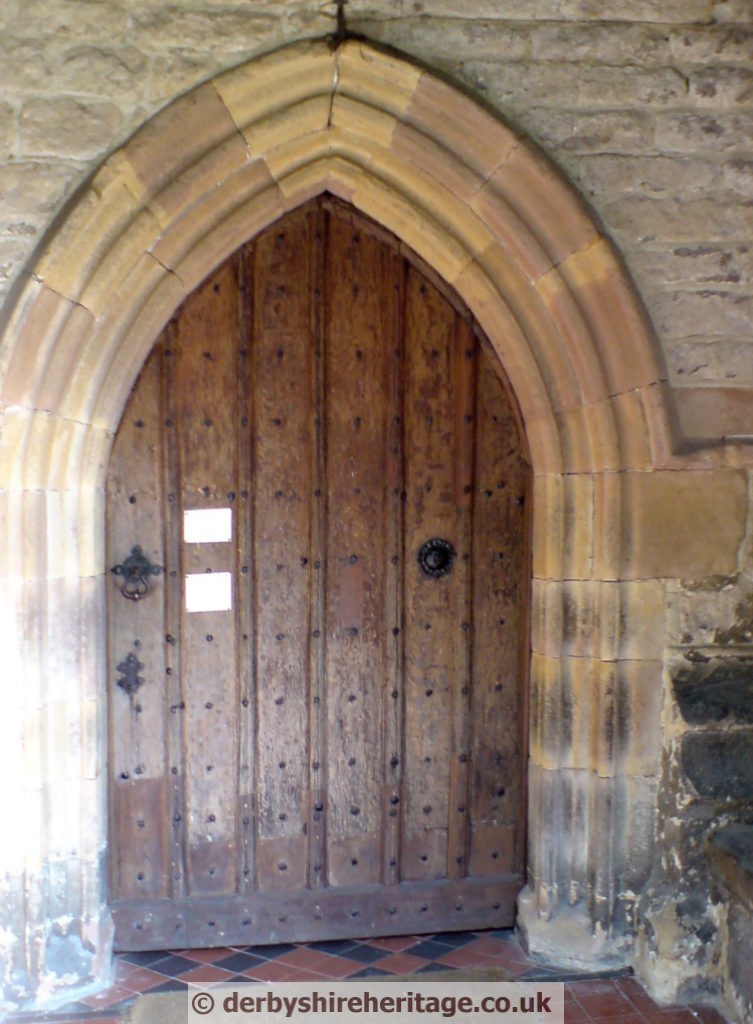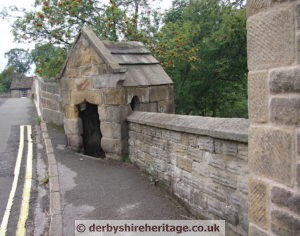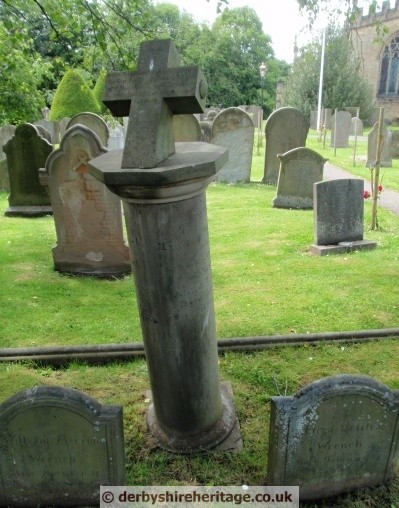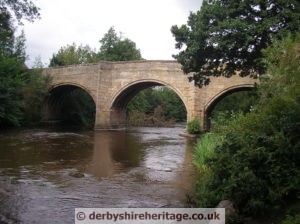BASLOW
Baslow was a settlement in Domesday Book, in the hundred of Blackwell and the county of Derbyshire.
It had a recorded population of 1.4 households in 1086, putting it in the smallest 20% of settlements recorded in Domesday (NB: 1.4 households is an estimate, since multiple places are mentioned in the same entry).
Baslow was recorded as Basselau in 1066, Bassalawa in 1157, Bassela in 1179 and Basselowe in 1242. Basselowe was derived from ‘Bassa’s Hill of burial mound’.
St Anne’s Church is Baslow church.
The tower has two clocks, on the north side is a ‘normal’ one, dated 1759, with conventional numerals but the east face clock is totally unique. In place of numerals this clock face has 12 letters and numerals which spell out – VICTORIA1897
In place of numerals this clock face has 12 letters and numerals which spell out – VICTORIA1897
This was the gift of Dr Wrench to commemorate Queen Victoria’s Diamond Jubilee.
Lt. Col. Edward Mason Wrench served in the Crimea with the 12th Lancers in the Indian mutiny. He took over a medical practice in Baslow in 1862 and also had medical responsibilities at Baslow Hydro and Darley Dale. He was made a Member of the Royal Victorian Order by King Edward VII on his last visit to Chatsworth.
Dr Wrench memorial
Edward Mason Wrench was the son of a City of London rector who served as an army surgeon in the Crimean War and later in India at the time of the Indian Mutiny.
He retired from the army and settled in Park Lodge, Baslow – where for the next 50 years he served as a physician and surgeon to the Chatsworth estate, to the 7th Duke of Devonshire, from 1862. Also physician to visiting royalty and to the people of Baslow until his death on a cycle ride in 1912 at the age of 78.
Not only was he extremely active and influential in the area, he left a physical mark on the area and a significant written one. His daily diary forms part of the extensive archive of his papers at Nottingham University.
He arranged for the erection of the Wellington Monument which was a balance to the more modest Nelson’s Monument on nearby Birchen Edge. Also he was responsible for the unique east-facing clock on Baslow Church and an unconventional stone commemoration in the area, The Jubilee rock in Chatsworth Park, both marking Queen Victoria’s 1897 Diamond Jubilee.
On Baslow church door is a sanctuary knocker – fugitives from justice would take hold of this and beg for entry into the church around the Middle Ages, they would then be safe from capture for as long as they stayed within the sanctuary of the church and the church bell would have been rung to warn the people of Baslow that the fugitive was within.
A glass case in Baslow church porch holds a dog whip. It was the dog whipper’s duty was to chase stray dogs from the church, keep animals in church in order and to prevent anyone in the congregation from dozing off.
In the 17th and 18th centuries it was common practice to employ a dog whipper. An annual wage was often paid – at Youlgrave the parish accounts show that in 1604 the dog whipper was paid 1s 4d (7p) annually and by 1716 this had not increased. At Castleton in 1722 the ‘sluggard waker’ was paid ten shillings and used a long wand to tap anyone on the shoulder who looked like dozing off.
The Baslow whip has a leather bound handle with a three foot thong.
The quaint Toll Booth, Watchman’s Hut or Hermitage is on the north west side of the old Baslow Bridge by what was The Rutland Arms and is now (2020) the Coop. It is not certain when it was built or if it actually was the site of toll collection. It first appears on a map in 1848 and was reputedly used for providing shelter to Baslow men who stopped miscreants from entering the village at night.
It is not certain when it was built or if it actually was the site of toll collection. It first appears on a map in 1848 and was reputedly used for providing shelter to Baslow men who stopped miscreants from entering the village at night.
However it might also have been an informal but very convenient shelter for the toll collector during inclement weather on a busy day when collecting money from travellers along the turnpike road over the old Baslow Bridge.
 Baslow old bridge is Grade I listed – Historic England
Baslow old bridge is Grade I listed – Historic England
In its present form mostly early C17. The date 1608 is inscribed on the south west wall. Sandstone ashlar. Three stepped round arches with six plain ribs below. Triangular cutwaters rising to the top to include the parapet. The bridge rises to the centre. Plain chamfer at the base of the parapet and the parapet copings chamfered on the outer side. The walls curve out at either end. Attached at the north west end is a small gabled toll booth with stone slate roof and coped gable with moulded kneelers. Doorway beneath a lintel with depressed ogee arch. Also scheduled as an Ancient Monument.
Baslow New Bridge called the “Devonshire Bridge” was built in 1924-5. It carries the main A619 between Chesterfield and Bakewell.
 Baslow Hydro was set of meticulously landscaped grounds in twelve acres on a raised plateau at the foot of Yeld Wood, where it dominated the right side of Tithebarn Lane, later renamed Eaton Hill. Present day Hydro Close was in the grounds. Unlike the mineral rich waters at Matlock and Buxton, the Baslow springs were peaty and organic.
Baslow Hydro was set of meticulously landscaped grounds in twelve acres on a raised plateau at the foot of Yeld Wood, where it dominated the right side of Tithebarn Lane, later renamed Eaton Hill. Present day Hydro Close was in the grounds. Unlike the mineral rich waters at Matlock and Buxton, the Baslow springs were peaty and organic.
Mr. Henry Pawson, a prominent Sheffield businessman founded the Eagle Tor Hydropathic Establishment with the assistance of the Duke of Rutland and Architect S. L. Swann. A sum of £20,000 was raised by selling 2000 shares in the new venture at £10 each.
On July 21, 1880, the foundation stone was laid by Edward Tozer, Chief Magistrate and Mayor of Sheffield in an elaborate ceremony attended by the Master Cutler, Alderman D. Ward, Chairman of the Directors, Mr. R.WM. Nesfield, the Duke’s agent, and a crowd of locals. It took approximately one year to construct.
On the ground floor were verandas on both sides of an impressive porch, privileged guests would find a large dining room at one end of the long corridor and a drawing room of similar dimensions at the other. Behind private sitting-rooms to the rear were two matching glass-roofed wings, each 58 feet long by thirty feet wide: one a ballroom, the other dedicated to billiards.
Higher floors contained accommodation for 150 people, separate stairways leading to Ladies’ and Gentlemens’ washrooms : the latter furnished with a large plunge-bath.
A basement contained the manager’s room, a kitchen, scullery, and servant quarters.
Outside, there was a fountain, waterfall, croquet lawn, bowling-green, small pond, boating-lake around an island, orchard – and a one and a half acre vegetable garden. Alternatively, guests had use of a nine-hole golf course, summerhouses and two double tennis-courts: tennis then being at the height of its popularity.
The Hydro owed its fame and fortune to an Edwardian-Victorian preoccupation with “healing” waters, spas and hydropathic treatments. Indeed, Smedley’s Hydro in nearby Matlock was one of the largest and best appointed in the whole of England – and the town of Matlock, at one time, hosted more than twenty other hydros.
Baslow’s Hydro remained profitable right up until the outbreak of World War 1, although it was not able to offer the fullest range of cures for gout, colic, apoplexy, dyspepsia, flatulence, indigestion and melancholia, because it lacked all the German, Russian or Turkish baths. A further twenty bedrooms were added, in a long wooden annexe, during the 1890s.
In 1899, Baslow Grand Hotel and Hydro’s application for a full drinks’ licence was rejected on the grounds that the village already had six licensed beerhouses. Thus residents could only drink wine and beer in the hotel or visit one of the local pubs if spirits were required.
After many profitable years the business went into decline. As travel became easier and more civilised the way was open to visit many other Hydros at home and abroad.
Added to that the Depression reduced the number of potential customers.
Baslow Hydro closed in 1930 leaving just Miss Gill the spindly caretaker.
Despite many rumours about a potential London buyer it was eventually sold for demolition with fixtures and fitting being auctioned off.
Contents of rooms were sold off with bedroom suites being sold for a pound, richly-upholstered armchairs for fifteen shillings; along with carpets, brass fireplaces and marble wash-stands.
Mr. White of Darley Dale paid £3000 for demolition rights. Demolition was completed in 1936.
A few remnants of Baslow Hydro still exist. There is a pair of gate-posts at the end of a bungalow drive on the crest of Eaton Hill. The fountain of Fountain House is also a relic of the Hotel and Moor Edge Bed and Breakfast Guest House is built from recovered stone. Both are located in the former Hydro grounds at Hydro Close.
Baslow Hall.
Even an architectural enthusiast may be forgiven for assuming that Baslow Hall is a typical 17th Century Derbyshire manor house. It has all the trademarks of that period: protruding gabled wings, mullioned and transomed windows with small leaded panes, and a splendid shell-porch over the main entrance.
The Hall was in fact built in 1907 and without doubt is a very skillful interpretation of a style of architecture that, even in Derbyshire, had gone out of fashion some 300 years earlier.
The house was built on land bought from the Duke of Rutland for the Stockdale family, benefactors to the village, whose name is commemorated by the Stockdale Institute and by a memorial in the church to the Rev. Jeremiah Stockdale, vicar of Baslow for nearly half a century in Victorian times. The locally quarried gritstone has weathered nicely over the past 90 years and the house looks as though it belongs to the 17th Century.
In 1913 the house was bought by the famous electrical engineer and inventor Sebastian Ziani de Ferranti, whose seventh and last child , Yvonne, was born at the Hall in July 1914.That the Ferranti’s were happy here is clear from Mrs de Ferranti’s charming biography of her husband, but it is equally evident that life at the Hall had its hazards, largely because ‘Basti'(as Mrs Ferranti affectionately called her husband), could not confine his passion for electricity to working hours. He was a ‘do-it-yourself’ man ahead of his time and certainly ahead of the coining of that phrase. That he did not install electrical light and power to the house until March 1919 could only have been due to wartime difficulties, but when he did go ahead there was no stopping him. After dismissing his original idea of using the old Baslow Mill for power because of the cost of repairing the old dam, he installed a 25h.p. oil engine and operated his own private plant until 1923. For heating the house he used radiators in the ceilings, an ingenious idea that was marred by frequent power failures, so that the family often sat huddled in fur coats through the long winter evenings. The system was speedily abandoned, and electrical fires were installed in every conceivable place.
The house became an electrician’s paradise with an electric laundry, electric lawn-mower, a tennis court lit by electric light and every modern labour-saving device that could be operated by electricity. Most of this seems to have worked most of the time, though a large number of chickens were inadvertently electrocuted in what was an early experiment in battery farming. There must have been doubts too about the heating, as a hot-air system was given a short trial.
After Mr de Ferranti’s death in 1930, the house was purchased by Mrs McCreagh-Thornhill of Stanton Hall, Stanton-in Peak and given to her grandson Mr Humphrey Davie as a wedding gift on his marriage to Elizabeth Barlow. Their first two children Bettine & Nicholas were born in the house in 1933 & 1936.The family lived at Baslow Hall very happily until the outbreak of war. Whilst Captain Humphrey Davie was on active service the house was let and re-let to the Kenning family, local car dealers who eventually purchased it in the early 1950’s. The Kenning family motto ‘work and pray’ is captured in the stained glass windows in the paneled hall. On Mr Kenning’s death in 1955 the house was sold and ownership passed to a second car dealer – T.C. Harrison, before being sold again to the Clixby family.
It was love at first sight when Max & Susan first set eyes on the house but it was to be some time before they were to open the doors to the public. During the course of refurbishment a devastating fire broke out in one wing, completely gutting it and creating a full year’s extra building work. But the time taken in rebuilding and refurbishing the house has been worthwhile and the Fischer’s are delighted by what Gertrude de Ferranti described as ‘this beautiful stone built house’ which is now quite free of any eccentricities of heating and lighting. The house might not be of any significant historical interest, but what it is is a charming, cheerful, family home.
Extensive information on The Alma and other pubs can be found at the Wishful Thinking website.
|
||||
| Situation | SK 25467250 | The present house north of the upper end of School Lane, is behind the old chapel. No doubt named after the Crimean Battle of Alma in 1854 | ||
| Tithe Award | CUNDY William, described as a Cooper in the 1841 Census, owned the building at the site of the present Alma building, and was also a tenant of the house next door to the east | |||
| GEESON Richard had a single large field between School Lane and Church Lane | ||||
| Gazetteers | ||||
| 1848 | GEESON Richard | Beerhouse for Berrys Beer | ||
| 1852 | Retailer of Beer | |||
| 1852 | Ale and Porter Dealer | |||
| 1860 | Ale & Porter Dealer Merchant | |||
| Note | Gazetteers make no mention of “The Alma” | |||
| Census | ||||
| 1851 | GEESON Richard (b.1796) | Ale and Porter Dealer. (Note: residence not known) |
||
| The Alma mentioned for first time in 1861 | ||||
| 1861 – 1871 | GEESON Ralph (b.1828) | Beer house Keeper at The Alma | Then his brother | |
| 1881 | GEESON Arthur (b.1852) | Innkeeper | at the Alma Beerhouse | |
| 1891 | FOWLER Charles (b.1841) | Publican | Then his widow | |
| 1901 | FOWLER Ellen (b.1841) | Licensed Victualler | ||
Perambulations of the Boundaries of Baslow.
from Wishful Thinking website –
There is information on Perambulations of the Boundaries of Baslow 1614, 1626 and 1721.
Compiled by David Dalrymple-Smith, © Copyright January 2005
It used to be a tradition for the population of towns and villages to walk around the boundaries of their parish every decade or so. Records were kept and some have survived to the present day.
It is difficult to follow the routes of these but the Hurkling Stone is mentioned in three Perambulations.
The 1614 Perambulation is especially interesting in that it mentions the Hurkling Stone which marked on the OS map at White Edge Moor. The 1625 Perambulation mentions the hurkins Stone (sic). In 1721 the Herklin (sic) Stone, marked on the North end, xMB.





